“Oaxaca, the belly of Mexico.”
“The country’s culinary capital.”
“To chefs what Paris was to painters.”
One of the reasons I wanted to go to Oaxaca (okay—the main reason) was to fill my belly with the myriad of moles (mo-layz, a thick mixture of chilies, spices, herbs, veggies and sometimes chocolate,) tamales (a corn-based dough filled with meat or beans and cheese then wrapped and cooked in corn husks), memelas (tortillas smeared with lard and topped with bean paste, cheese and salsa), tlayudas (oversized thin tortillas cooked on a smoky comal then layered with pork fat, refried beans, cheese, salsa and meat or veggies then eaten flat or folded)…
Every dish in Oaxaca has its own character, rooted in the flavours, techniques and ingredients of the sixteen different indigenous groups who have lived here for thousands of years. The infusion of other cultures is happening, but from what we saw and ate, tradition is thriving.
Oaxaca, the capital of the city’s eponymous state, has a population about the same as Vancouver’s but per capita they have even more places to eat. In the hours I spent researching where to fill my belly and getting suggestions from friends who have eaten there (thank you Val and Jaymie), I could have made a thousand tacos. In the time it took me to narrow the choices from sixty to twenty, I could have made a year’s supply of salsa.
Now, to Alfonsina.
On the outskirts of Oaxaca near the airport on a dirt road on his family’s rustic compound, a cook nicknamed “Moles” is changing the very concept of a restaurant.
Alfonsina has no menu.
Ostensibly it has no website; the only thing there is a reservation page.
It has no Facebook account, although people post photos on Instagram.
It has no formal kitchen, just partially open work spaces and baskets of fresh produce in a courtyard garden. The focal point is the large comal, a pile of firewood beside it.
It has no pretentious servers, no white tablecloths, no thrice-polished wine glasses, just a dozen or so rustic wooden tables surrounded by wood-slatted chairs on a cement slab in the garden.
What it does have is the best food we ate in Mexico and an all-round satisfying experience.
Alfonsina’s chef, Jorge León, comes from Santo Domingo Nundo, a village four hours away in the Mixteca region of Oaxaca. His family moved into the city when he was six years old, and his mother, Elvia soon began selling food from her kitchen and tortillas from her comal. Cooking wasn’t new to her. From the time she was seven years old when her mother passed away, Elvia has been at the head of a kitchen.
When he was a teenager wanting to earn some money, Jorge got a job as a dishwasher at one of Oaxaca’s best-known restaurants, Casa Oaxaca. He worked his way up the stations, his skills catching the eye of Chef Enrique Olvera, owner of the prestigious Pujol in Mexico City. Enrique hired him and Jorge moved to CDMX.
One day when Pujol’s chefs received a big order of Chilhuacle chiles, Jorge suggested using them in his family’s recipe for Mole Negro—a laborious dish that takes at least two days to make. Its complex flavour comes from different varieties of chile as well as garlic, onions, cinnamon, cloves, coriander, cumin, peppers, sesame, almonds, raisins, peanuts and chocolate—and possibly other secret ingredients. Soon Jorge took charge of the most important role in the kitchen, making moles based on Oaxacan recipes. The restaurant’s most famous dish became Mole Madre, earning Jorge the nickname “Moles.”
“It really opened my eyes to a whole new world,” Jorge has said in interviews. “When I arrived, Pujol was already a world-class restaurant, so I wasn’t sure how could I contribute to it. But, in the end, I was able to bring a bit of Oaxaca to the dishes, and that is something that will always make me proud.”
During the six years he worked for the Olvera group, Jorge sent money home. He bought a cornfield next to his family home and together with his parents, siblings, cousins and other relatives, they built the restaurant’s space from scratch. Alfonsina, named in honour of Elvia’s mother, opened in 2018.
It gets dark and cool by 6 pm in Oaxaca in January, so I made a reservation for lunch to enjoy the garden in the afternoon sun. I also prewarned Magellan, Karol and Gail of the 35-minute cab ride to the restaurant’s unusual location.
By the time we arrived, the restaurant had been busy for hours.
Elvia begins her day serving breakfast to neighbours and factory workers. It could be hot-off-the comal tortillas or something much more complicated like higaditos, a mixture of scrambled eggs, chicken broth and spices cooked in a pot set over wood charcoal in a wheelbarrow until it resembles a dense, savoury cake. For the midday meal, Elvia makes a hearty comida corrida, an affordable, set-price menu of an appetizer and main dish, to which she often adds an agua fresca or dessert. When we arrived for our 2 pm reservation, the locals who had eaten lunch at Alfonsina were back at work.
A fifth of Alfonsina’s business comes from the local community. While we were there, people passed by our table, shortcutting through the restaurant to another destination in the village of San Juan Bautista la Raya.
“We wanted to make this place comfortable for our community that dine with us, and for those who travel from all over the world to visit us,” Jorge has said—and done.
People love Elvia’s tortillas.
She and Jorge’s father continue the tradition of nixtamalization, soaking corn grown by Elvia’s sister in Santo Domingo Nundo in a lime solution before grinding it to enable the absorption of more nutrients when it’s cooked—a process no longer common in today’s world of industrialized tortilla production. The difference is remarkable, a world apart from other tortillas. Elvia’s are hardy, supple and taste of good corn.
Jorge calls his cooking “Cocina de Mercado,” which means changing the menu daily depending on what’s available at the market from small-scale farmers and fishermen from the nearby coast. Buying higher quality produce that’s same-day fresh and paying growers directly empowers local communities and preserves “the most all-encompassing expression of Mexican life, bountiful amounts of fresh, regional produce; an artful community-led exchange” that continues in Oaxaca and the towns surrounding the city, many that have their own special “Market Day.”
UNESCO has designated traditional Mexican cuisine an intangible cultural heritage gift to humanity—Jorge’s lunch menu is a gift of five presents: soup, tostada, mole, tamale and dessert—plus, Magellan and I went for the extra “dish of the day”, the tortilla gift.
The Mole Madre, served with a fried plantain and rice, was divine, perfection in the blend of ingredients. But it wasn’t my favourite dish.
Elvia’s tostadas are topped with a mixture of parsley, squash seeds, broccoli and kidney tomatoes (tastier because of their high sugar content and organic acids)and stir-fried with the juice of oranges and limes. One could be a vegetarian eating this.
And the tamale! Wrapped to perfection in a banana leaf. Inside masa dough was cooked with small bits of pork, chiles and cherry tomatoes “for a long time,” our capable young waitress, apprenticing here for six weeks, told us.
In the town of Tlacolula at the oldest market in Mexico, Magellan and I tried barbacoa, an authentic dish, typically made with goat or lamb seasoned with dried chilies and spices, covered with agave leaves and slow cooked in a hole in the ground until it’s pull-apart tender, then served on a tortilla with a line of green sauce. I’ve made a stove-top version at home that wasn’t as good as what we ate at Tlacolula, but tasty and make-again. Jorge elevates his barbacoa, the extra dish of the day, making it from Santo Domingo Nundo beef seasoned and cooked with adobe and other chiles and herbs, then rolled tight in Evira’s tortillas so they are not sloppy, but elegant and delicious. I could have eaten two or three more even though this was the last of our savoury dishes.
For dessert, there were five choices: citrus caramel with tamarind and chicos caramel served with fresh peaches and pears; plantain cooked on the comal and served with cream; jello (I know!) made from currants, pineapple and honey; a popsicle made from squash, sugar-cane syrup and lime; and a second popsicle made from black sapote fruit (which our waitress described as having a caramel/cocoa taste but a bit dry like persimmon) with walnut and lime zest. Of course, we had the black sapote popsicle. If I lived in Oaxaca I’d try to talk Jorge into selling me a box of them for the freezer.
But it is Jorge’s soup I dream about.
The colour: terracotta, earthy as the pottery on display in the courtyard. When I asked why the soup wasn’t fava-bean green, our waitress explained that it was made from dried fava beans.
The temperature: warm, warmer than room temperature, Mexican warm.
The texture: velvety smooth.
The taste: pure Oaxacan.
So, I emailed the restaurant:
Ciao,
We ate at our wonderful restaurant in January and now that’s almost squash blossom season here in Vancouver I am wondering if you are willing to share your recipe for squash blossom soup? It had the following ingredients according to our lovely waitress: Dried fava beans, squash blossoms, kidney tomatoes, hibiscus flowers, oranges, lime zest, an herbal mezcal mojo and was served with a sweet potato cookie.
Thank you in advance.
They replied immediately.
it was lunch or dinner ?
We usually don’t have a written recipe, but we could tell you the steps and you could try to make something similar 🙂
A few days later they emailed the recipe.
We are not sure what soup you ate, but here you have something to try 🙂Tomate riñon rojo tatemado
Cebolla tatemado
Ajo
Frijol rojo remojado
Chile morita
Hoja de aguacate/cilantro/hoja santa
1.- tatemar tomate riñon rojo y cebolla, limpiar exceso y picar la cebolla en 8 partes para facilitar el sofrito
2.- en una olla colocar aceite y empezar a sofreir la cebolla y el ajo hasta que se empiecen a sudar y a tornar color cafe, incorporar el tomate riñon y dejar que sude.
3.- en el sofrito agregar el frijol rojo yel chile morita para integrar sabores.
4.- cuando este bien cocido todo, licuar y re-sofreir y aromatizar con cualquier hierba al gusto. Rectificar salt.Hope you can work with this.
Translated, it reads,
Roasted red kidney tomato
grilled onion
Garlic
Soaked Red Bean
chile morita
avocado leaf/cilantro/hoja santa
1.- Tatemar red kidney tomato and onion, clean the excess and chop the onion into 8 parts to make it easier to fry
2.- Place oil in a pot and start to fry the onion and garlic until they start to sweat and turn brown, add the kidney tomato and let it sweat.
3.- in the sauce add the red beans and the morita chile to integrate flavors.
4.- when everything is well cooked, blend and re-fry and flavor with any herb to taste. rectify salt.
Alfonsina-Style Squash Blossom Soup
Ingredients
For the soup
- 1 Tbsp olive oil
- 1/2 medium onion, quartered
- 3 small tomatoes
- 1 small yellow zucchini
- 1 garlic clove, quartered
- 1/2 tsp salt
- 2 cups cooked broad beans
- 10 zucchini blossoms (7 for soup, 3 for serving)
- 1 hoja santa leaf (or sub a handful of cilantro)
- 1 dry chile morita (a type of chipotle)
- 1 Tbsp sweetened hibiscus flowers
- 3 slices orange
- 1 2-inch strip lime peel
- 3 cups water
- 1 Tbsp mezcal
- 1 Tbsp agave syrup (or sub sugar)
For the sweet-potato cookie
- 3 cups purple sweet potato, boiled and mashed
- 1/8 tsp salt
- 1/8 tsp pepper
- 1 green onion, finely chopped
- 1 Tbsp cilantro, finely chopped
- 1/2 tsp sweet paprika
- 1 Tbsp flour
- 1 egg lightly beaten
- canola oil for frying
Instructions
For the soup
- Grill the onion, tomatoes and zucchini.
- Separate the onion leaves. Chop the tomatoes and zucchini.
- Heat the olive oil. Cook the onion over medium heat ~ 15 minutes.
- Add the garlic and continue cooking for ~5 minutes.
- Add the tomatoes, zucchini slices and salt and cook for another `5 minutes.
- Add the broad beans, 7 zucchini blossoms, chili pieces, hoja santa, orange slices, lime strip and water. Bring to a boil, lower the heat and simmer for 15 minutes.
- Remove the lime strip and orange slices.
- Add the mezcal.
- Blend vigorously until as smooth as possible and strain through a sieve for a smoother consistency. Alternatively put the soup through a food mill if you have one. The texture should be like tomato soup.
- Salt to taste.
For the sweet potato cookie
- Mix all of the ingredients together.
- Form a bit less than 2 tablespoons of the dough into a ball and pat down. You will have 16-18 cookies, plenty leftover to serve with other dishes.
- Fry in canola oil heated to medium-high for 2 minutes per side.
To serve
- Cut the 3 remaining zucchini blossoms in half.
- Pour the soup (it’s nicest a bit warmer than room temperature) into six bowls. Add a sweet potato cookie to each bowl and a half zucchini blossom.
Alfonsina, the soul of Oaxaca.
Navigation
Alfonsina. Wednesday through Monday, Alfonsina offers three daily seatings at 1pm, 2pm and 7pm. Our waitress encouraged us to return for dinner, where the menu is more elaborate. Someday…

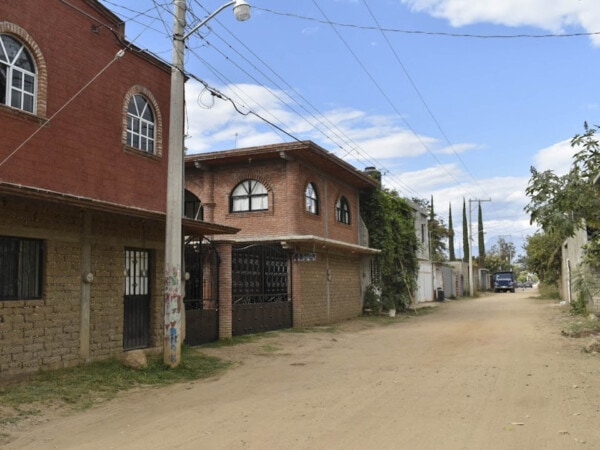






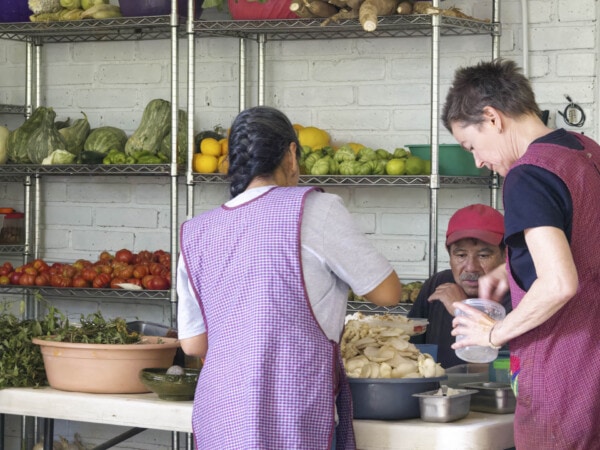

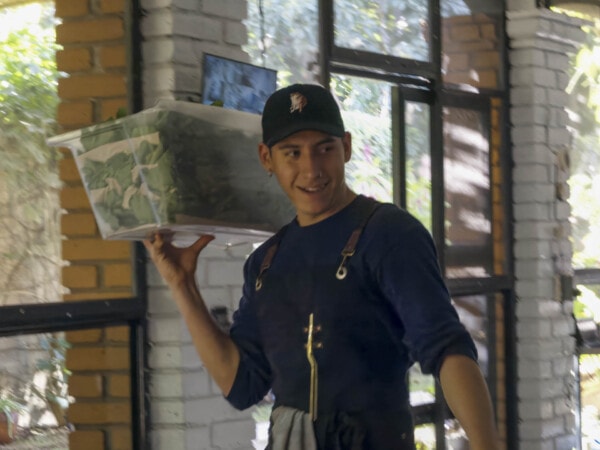
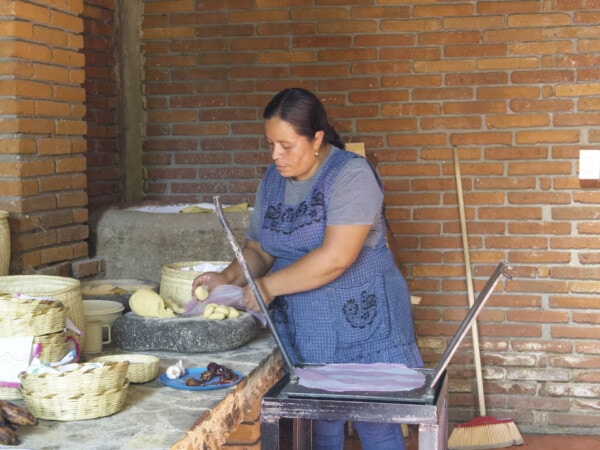
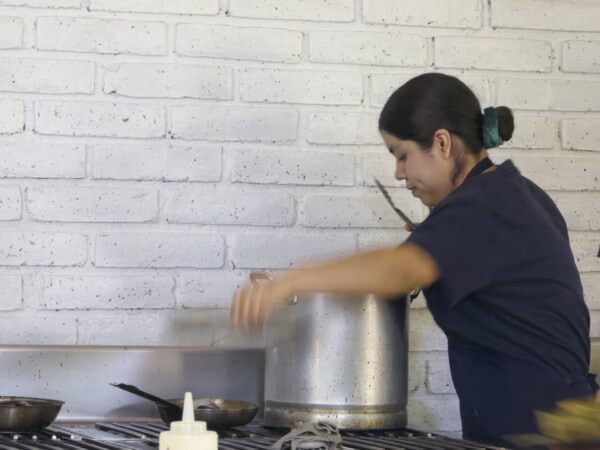

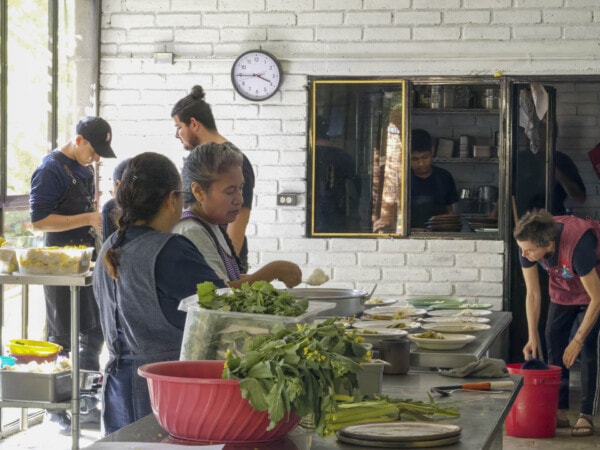







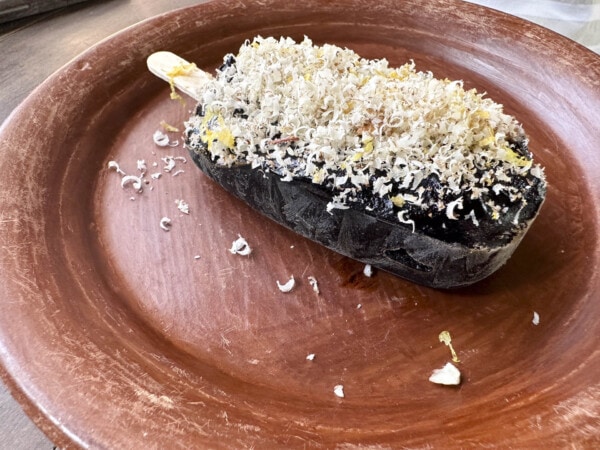






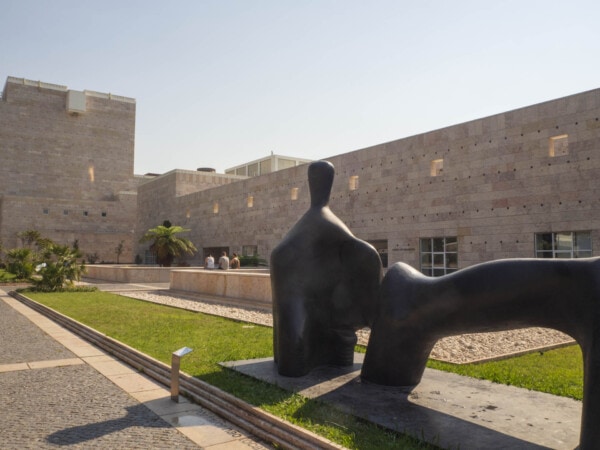
10 Responses
Wow, you are amazing…would love to enjoy this, but not sure
I have the expertise to create this feast! Thanks❤️🎶🍷
Who would attempt this whole meal other than a chef? But stovetop or oven barbacoa is easy to do and so is the soup.
I’m so impressed that you could reproduce the dish. I will definitely try the recipe!
Let me know how it turns out. I had to play with the amount of agave syrup to give it the sweetness in Jorge’s perfect blend. Also, the hibiscus flowers I have (from a woman mezcal maker outside Oaxaca) have a molasses sweetness compared to the ones you buy for cocktails.
Amazing!
By “Jorge” you’re right on that!
I can attest to Spice’s success in creating Squash Blossom Soup with purple potato cookies. It received oohs and ahhs from all. So happy to be invited to enjoy.
Ahhh, TY. My first attempt wasn’t as good as I puréed the orange and lime with the other ingredients, which gave the soup a bitter aftertaste.
Drooling now….
And all the ingredients are easily obtained here in YVR, even hola santa at Alimentaria Mexican at Granville Island.
